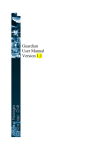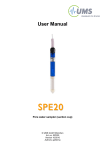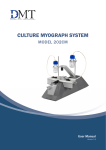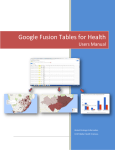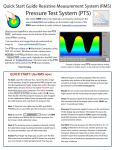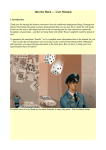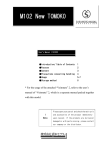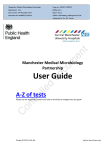Download SARASOTA MEMORIAL HOSPITAL NURSING PROCEDURE TITLE
Transcript
SARASOTA MEMORIAL HOSPITAL NURSING PROCEDURE PS1094 TITLE: BLOOD CULTURE COLLECTION PROCEDURE (spe20) ISSUED FOR: DATE: 6/10 REVIEWED: 5/15 PAGES: 1 of 4 RESPONSIBILITY: Nursing PURPOSE: RN-LPN II, select MST The staff member will follow standard procedures and protocols during blood culture collection in order to prevent contamination of the specimen. DEFINITIONS: Each blood culture order consists of two bottles defined as: one aerobic bottle (silver top) injected with 5-10 ml of blood and one anaerobic bottle (red top) injected with 5-10 ml of blood. Recovery of microorganisms is improved when using a smaller volume closer to the recommended 10 ml. EQUIPMENT: Equipment for Peripheral Venipuncture: 1. ChloraPrep One-Step Swabstick or equivalent (Chlorhexidine Gluconate 2% and Isopropyl Alcohol 70%). NOTE: Do not use on children less than 2 months of age. NOTE: For Pediatric patients, use Chloro Prep Sepp or equivalent 2. 70% alcohol swab 3. Blood culture bottles aerobic (silver) and anaerobic (red) NOTE: For pediatric patients, use single aerobic bottle (silver). 4. 5. 6. 7. Gauze Tourniquet Butterfly with short adapter or syringe 21 g, 12” Tubing with Multiple Sample Luer Adapter (Butterfly) 8. 22 or 23 g needle for patients with small or fragile veins 9. 23 gauge blood collection set (butterfly) for pediatric patients 10. Adhesive bandage 11. Non-Sterile gloves Note: Do not use blood collection supplies that are expired. Do not use if any defect is noted in the bottles such as cracks, contamination, excessive cloudiness, and bulging or indented stoppers. BLOOD CULTURE COLLECTION PROCEDURE (spe20) PROCEDURE: PAGE: 2 of 4 Procedure for Peripheral Venipuncture: 1. 2. 3. 4. Identify patient per SMH policies Perform hand hygiene. Don gloves. Select an appropriate venipuncture site. Vigorously cleanse the site with ChloraPrep for 30 seconds. Use gentle back-and-forth strokes to prep the site. 5. Allow the area to AIR dry. Do not blow or wave hand. 6. The bottle has been pre-marked with 5 ml increments. Mark the desired fill volume level on the bottle to 10 ml to help for correct volume collection. The blood culture bottles should be rubbed with an alcohol prep to disinfect the septum. Obtain the blood sample without touching cleaned site prior to drawing or site must be cleaned again (see step 4.) NOTE: Needle may be changed before inoculating the bottles if you have contamination issues documented. Safety devices must be activated before changing the needle. If there is a delay, sterile gauze may be used to cover the venipuncture site. 7. Using the adapter, insert the needle through the septum (top) of the aerobic bottles first (silver) and then the anaerobic bottle (red). Proceed with other blood specimens following the blood cultures. NOTE: Pediatric patients: use a syringe in order to ensure maximum volume withdrawn does not exceed 4 ml from the patient. Place in aerobic bottle. 8. If additional blood is required for other tests, insert tubes directly into adapter. 9. Remove needle from puncture site, activating safety device (push button butterfly needles remove the needle upon activation), and apply pressure to prevent bleeding. Discard sharps into a sharps container. 10. Cleanse area before bandaging if blood is visible. 11. Label the bottle with the appropriate label. Do not place label on top of the barcode label or the lot numbers. Orient patient label vertically for scanning efficiency. 12. Place bottles in plastic zip lock bag. If the blood culture bottles are to be sent via the tube system, individual biohazard bubble bags must also be used or pink blood culture transport tube needs to be used for safer transport. 13. Adult recommended fill is 5-10ml (do not fill over 10ml) and minimum is 0.5ml. 14. Pediatric patients over 12 recommended fill is 5-10ml (do not fill over 10ml), amount drawn depends on age of child and minimum is 0.5ml. 15. Neonate recommended fill is 0.5ml and absolute minimum is 0.1ml. NOTE: Pediatric Patients: Blood specimen may be obtained BLOOD CULTURE COLLECTION PROCEDURE (spe20) PAGE: 3 of 4 with IV start, following the above procedure. Nursing Staff Only – Central Line Draws (if ordered by the MD) 1. Clean needleless connector at connection to hub with 15 second scrub with alcohol. 2. Remove existing needleless connector. 3. Clean the hub of the central line catheter with 15 second scrub with alcohol. 4. Attach new primed needleless connector. 5. Do NOT discard blood waste. 6. Scrub the needleless connector with alcohol for 15 seconds. Allow to air dry naturally. 7. Collect one set of blood cultures only. 8. Flush the needleless connector and catheter until clear of blood residual. 9. Indicate on the blood culture bottle that the sample was withdrawn from the central line by writing “line draw”. (Infusion Nurse’s Society Policies and Procedures, pg. 135.) AFB Blood Culture Collection 1. 5 mls of blood is collected by the methods described above and inoculated into BacTAlert MB bottle (black cap) or equivalent. Contact micro department for the bottle prior to collection. 2. Specimen is delivered to the lab for processing. 3. An additional 1 ml of supplement, MB/BacT enrichment fluid is added and then incubated 6 weeks. Fungus or Yeast Blood Culture Collection 1. Regular 5-10 ml blood culture collection into the Aerobic (silver) bottle. 2. Specimen is delivered to the lab and incubated for 4 weeks. REFERENCES: Procedures for the Collection of Diagnostic Blood Specimens by Venipuncture; Approved Standard, 6th Edition, Clinical and laboratory Standards Institute, 2007. VersaTREKTM Automated Culture System, User Manual Version 2.1 Revision A October 2013. ChlorPrep manufacturer directions for use, CarFusion 12/23/2010. BD Persist Skin Prep Package Insert, 2011 BD Infusion Nurses Society. (2010).Infusion Nursing: An EvidenceBased Approach (3rd edition). St Louis, MO: Author. Infusion Nurses Society. (2011) 4th ed. Policies and procedures for infusion nursing. BLOOD CULTURE COLLECTION PROCEDURE (spe20) AUTHORS: Olevia Fulkert, Supervisor, Laboratory Chris Wirth, MSN, RN, Pediatrics Unit APPROVAL: Clinical Practice Council 5/7/15 PAGE: 4 of 4




